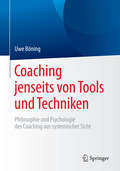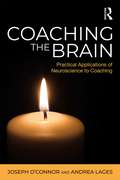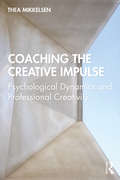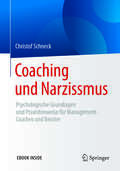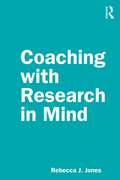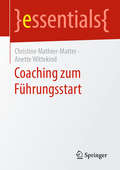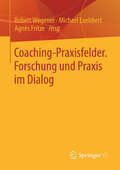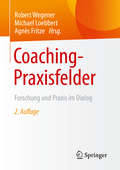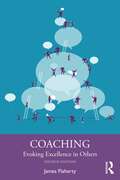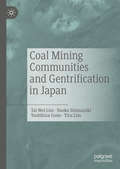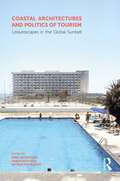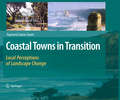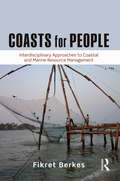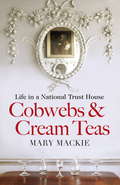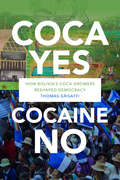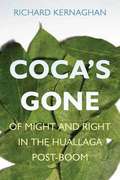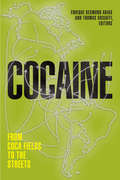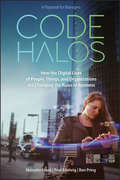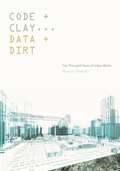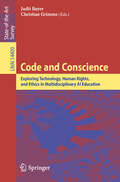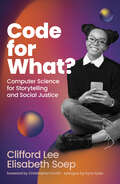- Table View
- List View
Coaching jenseits von Tools und Techniken: Philosophie und Psychologie des Coaching aus systemischer Sicht
by Uwe BöningOb Psychologie, Philosophie, Soziologie oder Kunst - all diese Disziplinen und weitere können fundamentales Rüstzeug fürs Coaching bieten. Sie liefern Denkweisen und Ideen, die einen qualitativen und herausfordernden theoretischen Rahmen und kreative Impulse für die Praxis darstellen. Uwe Böning, Coaching-Pionier und -Vordenker, stellt in diesem Buch zentrale Themen aus den genannten Disziplinen zusammen und vermittelt damit ein tieferes Verständnis und einen ganzheitlichen Blick für unterschiedliche Varianten und Qualitätsstufen in der Praxis: Worauf kommt es im Coaching im Kern an? Was macht es nachhaltig erfolgreich? Und was macht den Unterschied zwischen Handwerk und Kunst im Coaching? Es geht um Ideen und Verständnis, Hintergründe und Haltungen - statt um Tools und Techniken. Ein Buch für Coaches und Coaching-Ausbilder, Berater, Führungskräfte und Personalmanager.
Coaching the Brain: Practical Applications of Neuroscience to Coaching
by Joseph O'Connor Andrea LagesEverything we do, and sense, happens through our brain. In Coaching the Brain: Practical Applications of Neuroscience to Coaching, highly experienced coaches Joseph O’Connor and Andrea Lages ask and answer the question: ‘How can we use our knowledge of the brain to help ourselves and others to learn, change, and develop?’. This book will show you how to apply insights from the latest neuroscience research in a practical way, in the fields of personal development, coaching and cognitive therapy. Accessible and practical, it begins with an overview of how the brain works along with an explanation of how our brain changes due to our actions and thoughts, illuminating how these habits can be changed through neuroplasticity. Understanding the neuroscience of goals and mental models helps us to work with and change them, and clarity about emotions and the emotional basis of values can help achieve happiness. Most importantly, neuroscience illuminates how we learn, as well as the power of expectations. The book also explores the key lessons we can take from neuroscience for high performance and leadership. Eminently accessible, this book gives you new tools to help yourself and others create better futures. As a whole, the book will provide you with a new respect for the depth and complexity of your thinking and emotions. Coaching the Brain: Practical Applications of Neuroscience to Coaching, with its clarity and practical application, will be essential reading for coaches in practice and in training, as well as leaders, coach supervisors and HR and L&D professionals, and will be a key text for academics and students of coaching and coaching psychology.
Coaching the Creative Impulse: Psychological Dynamics and Professional Creativity
by Thea MikkelsenIn Coaching the Creative Impulse, Thea Mikkelsen presents an accessible and engaging guide to understanding and utilizing creativity at work. This unique book will give professionals and creative individuals a set of tools to help tackle and understand more deeply the psychological obstacles that may arise when navigating their career path, allowing them to thrive in their roles and master their craft. Based both in practice and in theory, Mikkelsen’s innovative approach is framed around Freud’s structural model of the superego, ego and id and Mikkelsen's decade worth of experience as a coach and leadership developer. She begins by clearly defining creativity and goes on to identify the psychological processes involved, considering the contribution of language, professional relationships, motivation and working as a group. Using case studies throughout, Mikkelsen also assesses the causes of creative blocks, the value of external feedback and the challenge of balancing experiences of success and failure. Featuring rewritings of real examples from her own work with professional creatives, this book provides a framework for managing inner conflicts and discovering a creative destiny. This state-of-the-art guide will be essential reading for all people who want to use their creativity and their personality in their work, and those who coach, lead and manage them. It will be of great interest to anyone working in a creative, technological or innovation-led industry, to HR and L&D professionals and to coaches of all backgrounds.
Coaching und Narzissmus: Psychologische Grundlagen und Praxishinweise für Management-Coaches und Berater
by Christof SchneckDieses kompakte Fachbuch bietet einen #65533;berblick #65533;ber Narzissmus und narzisstische Ph#65533;nomene im Management-Umfeld und skizziert einen idealtypischen Verlauf eines Management-Coachings von narzisstischen Pers#65533;nlichkeiten. Neben psychologischem und psychodynamischem Grundwissen zum Narzissmus wird dessen Allgegenw#65533;rtigkeit im Management und deshalb auch im Coaching beschrieben. Management-Coaches finden in diesem praxisnahen Ratgeber konkrete Hinweise zu allen Phasen des Coaching-Prozesses. Ein Buch f#65533;r Management-Coaches, Trainer und Berater, aber auch f#65533;r F#65533;hrungskr#65533;fte und Projektleiter, die mit dem Ph#65533;nomen Narzissmus konfrontiert sind, beispielsweise in Person des Vorgesetzten, oder die den Mut haben, ihre eigenen narzisstischen Anteile zu reflektieren.
Coaching with Research in Mind
by Rebecca J. JonesHow can coaches maximise the effectiveness of their practice? What can research tell us about how and why coaching ‘works’? How can we use the evidence base to enable others to reach their full potential? Coaching with Research in Mind brings together cutting-edge research in coaching and psychology, accessibly summarises the findings, and provides a clear and specific breakdown of what research tells us coaches and leaders should be doing and why. Rebecca J. Jones provides practitioners with the information and guidance they need to apply research in their practice, explaining how coaches can understand coachee characteristics, how they impact the coaching process and how coaches should adapt their practice to accommodate them. The book explains how to identify which principles of the coaching process influence effectiveness and tailor practice to maximise their impact. Jones also explores the impact of environmental factors and assesses how their influence can be limited. Coaching with Research in Mind will be essential reading for both new and experienced coaches looking to enhance the effectiveness and impact of their coaching, and for managers, leaders and L&D procurers who utilise coaching as a leadership style.
Coaching zum Führungsstart (essentials)
by Christine Mathier-Matter Anette WittekindEin Schritt auf der Karriereleiter wird zunächst positiv erlebt. Doch vieles entpuppt sich für die neue Führungskraft schnell als anspruchsvoll. Nicht gut gemeisterte Anfangssituationen in der Führung führen oft zu Problemen mit dem Team. Daher lohnt sich die Investition in eine Begleitung der neuen Führungskraft, nicht nur für diese selber, sondern für die gesamte Organisation. Der Fokus dieses essentials liegt auf dem Coaching zum Führungsstart. Coaches und Führungskräfte erhalten einen Einblick in erprobte Vorgehensweisen und eine Übersicht zu „Best Practice“, um die Führungskraft optimal auf die neue Rolle vorzubereiten. Die Theorie wird durch Fallbeispiele ergänzt.
Coaching-Praxisfelder. Forschung und Praxis im Dialog: Forschung Und Praxis Im Dialog
by Robert Wegener, Michael Loebbert and Agnès FritzeCoaching ist längst nicht mehr nur in der Führungskräfteentwicklung und im Sport anzutreffen. Auch im Kontext weiterer Handlungsfelder wie beispielsweise der Politik, dem Gesundheitssektor, der Sozialen Arbeit oder der Wissenschaft findet Coaching vermehrt Verbreitung. Die rasche Weiterentwicklung von Coaching aufnehmend, leistet diese Publikation einen Beitrag dazu, die Konturen der immer deutlicher erkennbaren Coaching-Praxisfelder nachzuzeichnen. Mit den Beiträgen international namhafter Expertinnen und Experten aus dem deutsch- und englischsprachigen Raum werden dazu aktuelle Erkenntnisse aus Wissenschaft und Praxis präsentiert. Einen weiteren Teil der Publikation bilden Coaching-Praxisfelder übergreifende Themen wie Coaching-Programme, moderne Medien und Evaluationsansätze.
Coaching-Praxisfelder: Forschung und Praxis im Dialog
by Michael Loebbert Robert Wegener Agnès FritzeCoaching ist längst nicht mehr nur in der Führungskräfteentwicklung und im Sport anzutreffen. Auch in weiteren Handlungsfeldern wie beispielsweise der Politik, dem Gesundheitssektor, der Sozialen Arbeit oder der Wissenschaft findet Coaching vermehrt Verbreitung. Diese rasante Entwicklung aufgreifend, versucht die Publikation die Konturen der immer deutlicher erkennbaren Coaching-Praxisfelder nachzuzeichnen. Mit Beiträgen namhafter Expertinnen und Experten aus dem deutsch- und englischsprachigen Raum werden dazu aktuelle Erkenntnisse aus Wissenschaft und Praxis präsentiert. Einen weiteren Teil der Publikation bilden Coaching-Praxisfelder übergreifende Themen wie Programme, moderne Medien und Evaluationsansätze im Coaching.
Coaching: Angewandte Psychologie für die Beratungspraxis
by Eric LippmannCoaching ist in aller Munde, die Angebote sind zahlreich, der Markt ist mittlerweile von vermeintlich neuen "Tools", Techniken und Ansätzen etc. fast übersättigt und sehr unübersichtlich. Diese Buch hilft, den Überblick zu behalten. Es stellt wirklich relevante Coaching-Ansätze nach einheitlichem Raster vor: Das Wichtigste in Kürze, typische Fragestellungen, Fallbeispiele, Erfolgskriterien für Berater, Besonderheiten einzelner Zielgruppen. Es informiert über wichtige Settings im Coaching-Prozess: Einzeln, in der Gruppe, kollegial, extern oder intern, als Selbst- oder Online-Coaching. Es hilft bei der Abstimmung auf bestimmte Zielgruppen: Coaching für Führungskräfte auf allen Managementebenen, im Familienunternehmen, für Schulleiter oder Lehrer, im Personalmanagement oder in der Politik. Es gibt Tipps für unterschiedliche Anwendungsfelder: Coaching bei Veränderungsprozessen, bei Konflikten, im Rahmen der betrieblichen Bildung, im Umgang mit Medien, bei Laufbahnfragen, bei Freistellungen. Kurz: Es ist ein Standardwerk für Praktiker, geschrieben von Top-Fachleuten der Branche - nun in überarbeiteter dritter Auflage und mit neuen Kapiteln zu psychodynamischen Ansätzen, Diversity-Aspekten oder Coaching im Sport. Mit Serviceteil für Coaches und Coachees: Suche und Auswahl von Coaches, Links für Coaches zu Aus- und Weiterbildungen, Kongressen, Zeitschriften, kommentierte Literaturtipps.
Coaching: Evoking Excellence in Others
by James FlahertyNow in its fourth edition, the bestselling, seminal book by James Flaherty, Coaching: Evoking Excellence in Others, is an insightful, thought-provoking, pragmatic guide that dissects the art and science of coaching. This fourth edition includes two brand new chapters: the first is on finding one’s inner guidance and purpose in traversing the world of work, especially in more uncertain working environments; and the second is on the topic of somatic intelligence. As in earlier editions, this foundational book in coaching clearly presents the theories, concepts, and models, and then moves on to consider rigorous methods of practice and self-observation in a relationship of mutual trust, respect, and freedom of expression. It will probe you to rethink how you relate to your clients and your staff, how you produce long-term excellent performance in yourself, and how you can become more effective in helping others to achieve their goals. Coaching, Fourth Edition is a rich learning resource guide for new and experienced coaches who want to challenge their methods of partnering with clients. It is also an inspiring guide for training managers and leaders, human resource development managers, and general managers who want to develop their teams.
Coal Mining Communities and Gentrification in Japan
by Tai Wei Lim Naoko Shimazaki Yoshihisa Godo Yiru LimThis book offers a multidisciplinary analysis of approach in the field of energy studies of Japan, examining post-closure coal mining towns in Japan and their gentrification. It considers the impact of closures on the agricultural industry, the re-absorption of laid off coal miners into service and industrial sectors, and the gentrification of former coal mines into agricultural farms and communities. It also considers the historical process of gentrification in terms of origins, social history, continuity/discontinuity and cooperation/resistance. The historical background of coal mine closures analyses nostalgic recollection about mine closures and Sakubei's UNESCO drawings of life in the coal mines and other cultural materials related to coal energy and the mining industry in general in Japan.
Coastal Architectures and Politics of Tourism: Leisurescapes in the Global Sunbelt
by Sibel BozdoǧanThis volume offers a critical and complicated picture of how leisure tourism connected the world after the World War II, transforming coastal lands, traditional societies, and national economies in new ways. The 21 chapters in this book analyze selected case studies of architectures and landscapes around the world, contextualizing them within economic geographies of national development, the geopolitics of the Cold War, the legacies of colonialism, and the international dynamics of decolonization. Postwar leisure tourism evokes a rich array of architectural spaces and altered coastal landscapes, which is explored in this collection through discussions of tourism developments in the Mediterranean littoral, such as Greece, Turkey, and southern France, as well as compelling analyses of Soviet bloc seaside resorts along the Black Sea and Baltic coasts, and in beachscapes and tourism architectures of western and eastern hemispheres, from Southern California to Sri Lanka, South Korea, and Egypt. This collection makes a compelling argument that "leisurescapes," far from being supra-ideological and apolitical spatial expressions of modernization, development, and progress, have often concealed histories of conflict, violence, social inequalities, and environmental degradation. It will be of interest to architectural and urban historians, architects and planners, as well as urban geographers, economic and environmental historians.
Coastal Architectures and Politics of Tourism: Leisurescapes in the Global Sunbelt
by Sibel BozdoǧanThis volume offers a critical and complicated picture of how leisure tourism connected the world after the World War II, transforming coastal lands, traditional societies, and national economies in new ways.The 21 chapters in this book analyze selected case studies of architectures and landscapes around the world, contextualizing them within economic geographies of national development, the geopolitics of the Cold War, the legacies of colonialism, and the international dynamics of decolonization. Postwar leisure tourism evokes a rich array of architectural spaces and altered coastal landscapes, which is explored in this collection through discussions of tourism developments in the Mediterranean littoral, such as Greece, Turkey, and southern France, as well as compelling analyses of Soviet bloc seaside resorts along the Black Sea and Baltic coasts, and in beachscapes and tourism architectures of western and eastern hemispheres, from Southern California to Sri Lanka, South Korea, and Egypt. This collection makes a compelling argument that "leisurescapes," far from being supra-ideological and apolitical spatial expressions of modernization, development, and progress, have often concealed histories of conflict, violence, social inequalities, and environmental degradation. It will be of interest to architectural and urban historians, architects and planners, as well as urban geographers, economic and environmental historians.
Coastal Geography in Northeast Brazil: Analyzing Maritimity in the Tropics (SpringerBriefs in Latin American Studies)
by Eustogio Wanderley Correia DantasThis book studies the transformation of modern maritimity practices in coastal areas (such as swimming, navigation and tourism) and their implications to the development of Brazilian coastal cities, with an emphasis on the Northeast part of the country. It is a reflection on coastal geography in the tropics and the contemporary valorization of coastal cities from a socioeconomic, technological and symbolical point of view. The book highlights local fluxes on a regional and local scale, showing the incorporation of beach zones to spaces which were previously associated with so called traditional coastal practices (fishing activities and as harboring points). This book is dedicated to geography researchers and students.
Coastal Towns in Transition: Local Perceptions of Landscape Change
by Raymond James GreenMany coastal areas around the world are experiencing dramatic landscape changes as a result of increased tourism development and the "sea change phenomenon" - the migration of affluent urbanites to small coastal towns seeking beautiful, natural surroundings. In response to these changes local residents in these places often complain that the distinctive character of their towns and/or individual neighborhoods is being lost or degraded. Coastal Towns in Transition looks at how changes due to unsympathetic development of the built environment and modification of the natural landscape are perceived to negatively impact on the character of small coastal towns. The book explores the concept of town character, and associated notions of sense of place, genius loci and place identity, as conceptualised by local residents in several coastal town communities along Australia's Great Ocean Road. Findings of a four-year study involving over 1800 respondents from these communities are used to explore theoretical and methodological issues associated with the assessment of place character in the context of coastal towns that are experiencing rapid environmental change. This book will be of interest to planners and environmental designers, as well as scholars in both landscape studies and social science and planning fields who are interested in the sustainable development of coastal areas. The case studies and associated planning and design strategies, together with the bibliography of selected relevant literature, will provide an invaluable reference for these scholars.
Coasts for People: Interdisciplinary Approaches to Coastal and Marine Resource Management
by Fikret BerkesIssues of sustainability and increased competition over coastal resources are changing practices of resource management. Societal concerns about environmental degradation and loss of coastal resources have steadily increased, while other issues like food security, biodiversity, and climate change, have emerged. A full set of social, ecological and economic objectives to address these issues are recognized, but there is no agreement on how to implement them. This interdisciplinary and "big picture book" – through a series of vivid case studies from environments throughout the world – suggests how to achieve these new resource management principles in practical, accessible ways.
Cobwebs and Cream Teas
by Mary MackieA warm and funny account of what it is like to live in and run a National Trust house: Felbrigg Hall in Norfolk.When Mary Mackie's husband became Houseman at Felbrigg Hall in Norfolk she suddenly found herself running one of the most elegant 17th-century houses in East Anglia. During their first year living in the National Trust house she was endlessly running up and down corridors, making visitors welcome, keeping unwelcome visitors at bay, arranging concerts, dinners and vast cleaning programmes. But leavening all the hard work were the exciting discoveries - hidden staircases, treasures in the attic and an ice house in the woods. COBWEBS AND CREAM TEAS reveals the tribulations and excitement that occur in any house open to the public, and it assures us that living in a National Trust house provides only the certainty that life will never be dull, or idle, again.
Cobwebs and Cream Teas
by Mary MackieA warm and funny account of what it is like to live in and run a National Trust house: Felbrigg Hall in Norfolk.When Mary Mackie's husband became Houseman at Felbrigg Hall in Norfolk she suddenly found herself running one of the most elegant 17th-century houses in East Anglia. During their first year living in the National Trust house she was endlessly running up and down corridors, making visitors welcome, keeping unwelcome visitors at bay, arranging concerts, dinners and vast cleaning programmes. But leavening all the hard work were the exciting discoveries - hidden staircases, treasures in the attic and an ice house in the woods. COBWEBS AND CREAM TEAS reveals the tribulations and excitement that occur in any house open to the public, and it assures us that living in a National Trust house provides only the certainty that life will never be dull, or idle, again.
Coca Yes, Cocaine No: How Bolivia's Coca Growers Reshaped Democracy
by Thomas GrisaffiIn Coca Yes, Cocaine No Thomas Grisaffi traces the political ascent and transformation of the Movement toward Socialism (MAS) from an agricultural union of coca growers into Bolivia's ruling party. When Evo Morales—leader of the MAS—became Bolivia's president in 2006, coca growers celebrated his election and the possibility of scaling up their form of grassroots democracy to the national level. Drawing on a decade of ethnographic fieldwork with coca union leaders, peasant farmers, drug traffickers, and politicians, Grisaffi outlines the tension that Morales faced between the realities of international politics and his constituents, who, even if their coca is grown for ritual or medicinal purposes, are implicated in the cocaine trade and criminalized under the U.S.-led drug war. Grisaffi shows how Morales's failure to meet his constituents' demands demonstrates that the full realization of alternative democratic models at the local or national level is constrained or enabled by global political and economic circumstances.
Coca's Gone: Of Might and Right in the Huallaga Post-boom
by Richard KernaghanFrom the mid-1970s to the mid-1990s, the Upper Huallaga Valley in Peru experienced an economic boom based on the illicit cocaine trade while simultaneously experiencing contestations for control between the Peruvian state and the Shining Path guerrilla group. In this ethnography of the valley conducted in the wake of that boom, Kernaghan (sociology and anthropology, Fordham U. at Lincoln Center) particularly focuses on experiences and narratives of law and violence as they relate to processes of state formation. Annotation ©2009 Book News, Inc., Portland, OR (booknews.com)
Cocaine: From Coca Fields to the Streets
by Enrique Desmond Arias and Thomas GrisaffiThe contributors to Cocaine analyze the contemporary production, transit, and consumption of cocaine throughout the Americas and the illicit economy's entanglement with local communities. Based on in-depth interviews and archival research, these essays examine how government agents, acting both within and outside the law, and criminal actors seek to manage the flow of illicit drugs to both maintain order and earn profits. Whether discussing the moral economy of coca cultivation in Bolivia, criminal organizations and drug traffickers in Mexico, or the routes cocaine takes as it travels into and through Guatemala, the contributors demonstrate how entire ways of life are built around cocaine commodification. They consider how the authority of state actors is coupled with the self-regulating practices of drug producers, traffickers, and dealers, complicating notions of governance and of the relationships between economic and moral economies. The collection also outlines a more progressive drug policy that acknowledges the important role drugs play in the lives of those at the urban and rural margins.Contributors. Enrique Desmond Arias, Lilian Bobea, Philippe Bourgois, Anthony W. Fontes, Robert Gay, Paul Gootenberg, Romain Le Cour Grandmaison, Thomas Grisaffi, Laurie Kain Hart, Annette Idler, George Karandinos, Fernando Montero, Dennis Rodgers, Taniele Rui, Cyrus Veeser, Autumn Zellers-León
Code Halos: How the Digital Lives of People, Things, and Organizations are Changing the Rules of Business
by Paul Roehrig Ben Pring Malcolm FrankHarness "Code Halos" to gain competitive advantage in the digital era Amazon beating Borders, Netflix beating Blockbuster, Apple beating Kodak, and the rise of companies like Google, LinkedIn, and Pandora are not isolated or random events. Today's outliers in revenue growth and value creation are winning with a new set of rules. They are dominating by managing the information that surrounds people, organizations, processes, and products—what authors Malcolm Frank, Paul Roehrig, and Ben Pring call Code Halos. This is far beyond “Big Data” and analytics. Code Halos spark new commercial models that can dramatically flip market dominance from industry stalwarts to challengers. In this new book, the authors show leaders how digital innovators and traditional companies can build Code Halo solutions to drive success. The book: Examines the explosion of digital information that now surrounds us and describes the profound impact this is having on individuals, corporations, and societies; Shows how the Crossroads Model can help anticipate and navigate this market shift; Provides examples of traditional firms already harnessing the power of Code Halos including GE's "Brilliant Machines," Disney's theme park "Magic Band," and Allstate's mobile devices and analytics that transform auto insurance. With reasoned insight, new data, real-world cases, and practical guidance, Code Halos shows seasoned executives, entrepreneurs, students, line-of-business owners, and technology leaders how to master the new rules of the Code Halo economy.
Code and Clay, Data and Dirt: Five Thousand Years of Urban Media
by Shannon MatternFor years, pundits have trumpeted the earthshattering changes that big data and smart networks will soon bring to our cities. But what if cities have long been built for intelligence, maybe for millennia? In Code and Clay, Data and Dirt Shannon Mattern advances the provocative argument that our urban spaces have been &“smart&” and mediated for thousands of years.Offering powerful new ways of thinking about our cities, Code and Clay, Data and Dirt goes far beyond the standard historical concepts of origins, development, revolutions, and the accomplishments of an elite few. Mattern shows that in their architecture, laws, street layouts, and civic knowledge—and through technologies including the telephone, telegraph, radio, printing, writing, and even the human voice—cities have long negotiated a rich exchange between analog and digital, code and clay, data and dirt, ether and ore. Mattern&’s vivid prose takes readers through a historically and geographically broad range of stories, scenes, and locations, synthesizing a new narrative for our urban spaces. Taking media archaeology to the city&’s streets, Code and Clay, Data and Dirt reveals new ways to write our urban, media, and cultural histories.
Code and Conscience: Exploring Technology, Human Rights, and Ethics in Multidisciplinary AI Education (Lecture Notes in Computer Science #14400)
by Christian Grimme Judit BayerThis volume originated from an international, interdisciplinary research course organized by the Institute of Information Management of the University of Münster in 2021-2022, funded by the DAAD IVAC sponsorship program. The coauthors and their contributions represent different disciplines, fusing perspectives of law and information sciences. The contributions present current issues in AI, ethics and human rights, policing, privacy and surveillance, social media, and data protection. The book has a further mission: it offers insight into a novel educational format that combines an intercultural learning environment with interdisciplinary co-working, e-learning methods, peer education, and interactive group work.
Code for What?: Computer Science for Storytelling and Social Justice
by Elisabeth Soep Clifford LeeCoding for a purpose: helping young people combine journalism, data, design, and code to make media that makes a difference.Educators are urged to teach &“code for all&”—to make a specialized field accessible for students usually excluded from it. In Code for What? Clifford Lee and Elisabeth Soep instead ask the question, &“code for what?&” What if coding were a justice-driven medium for storytelling rather than a narrow technical skill? What if &“democratizing&” computer science went beyond the usual one-off workshop and empowered youth to create digital products for social impact? Lee and Soep answer these questions with stories of a diverse group of young people in Oakland, California, who combine journalism, data, design, and code to create media that make a difference. These teenage and young adult producers created interactive projects that explored gendered and racialized dress code policies in schools; designed tools for LBGTQ+ youth experiencing discrimination; investigated facial recognition software and what can be done about it; and developed a mobile app to promote mental health through self-awareness and outreach for support, and more, for distribution to audiences that could reach into the millions. Working with educators and media professionals at YR Media, an award-winning organization that helps young people from underserved communities build skills in media, journalism, and the arts, these teens found their own vibrant answers to &“why code?&” They code for insight, connection and community, accountability, creative expression, joy, and hope.
